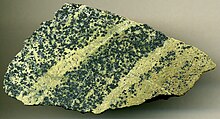Our website is made possible by displaying online advertisements to our visitors.
Please consider supporting us by disabling your ad blocker.
Serpentinite




Serpentinite is a metamorphic rock composed predominantly of serpentine group minerals formed by serpentinization of mafic or ultramafic rocks. The ancient origin of the name is uncertain; it may be from the similarity of its texture or color to snake skin.[1] Greek pharmacologist Dioscorides (AD 50) recommended eating this rock to prevent snakebite.[2]
Serpentinite has been called serpentine or serpentine rock, particularly in older geological texts and in wider cultural settings.[3][4][5][6][7]
Most of the chemical reactions necessary to synthesize acetyl-CoA, essential to basic biochemical pathways of life, take place during serpentinization. Serpentinite thermal vents are therefore considered a candidate for the origin of life on Earth.
- ^ Schoenherr, Allan A. (11 July 2017). A Natural History of California: Second Edition. Univ of California Press. pp. 35–. ISBN 9780520295117. Retrieved 6 May 2017.
- ^ Faust, George T.; Fahey, Joseph J. (1962). "The Serpentine-Group Minerals" (PDF). USGS Numbered Series (384-A): 3. doi:10.3133/pp384A. Retrieved 27 September 2024.
The Term Serpentine
- ^ "serpentine". Merriam-Webster.com Dictionary. Merriam-Webster. Retrieved 6 March 2022.
- ^ California Government Code § 425.2; see "CA Codes (Gov:420-429.8)". Archived from the original on 28 June 2009. Retrieved 24 December 2009.
- ^ Oakeshott, G.B. (1968). "Diapiric Structures in Diablo Range, California". AAPG Special Volume M8:Diapirism and Diapirs. 153: 228–243.
- ^ Flett, J.S. (1913). "The geology of the lizard". Proceedings of the Geologists' Association. 24 (3): 118–133. Bibcode:1913PrGA...24..118F. doi:10.1016/S0016-7878(13)80008-9.
- ^ González-Mancera, G.; Ortega-Gutiérrez, F.; Nava, N.E.; Arriola, H.S. (2003). "Mössbauer Study of Serpentine Minerals in the Ultramafic Body of Tehuitzingo, Southern Mexico". Hyperfine Interactions. 148 (1–4): 61–71. Bibcode:2003HyInt.148...61G. doi:10.1023/B:HYPE.0000003765.32151.3b. S2CID 96761317.
Previous Page Next Page


